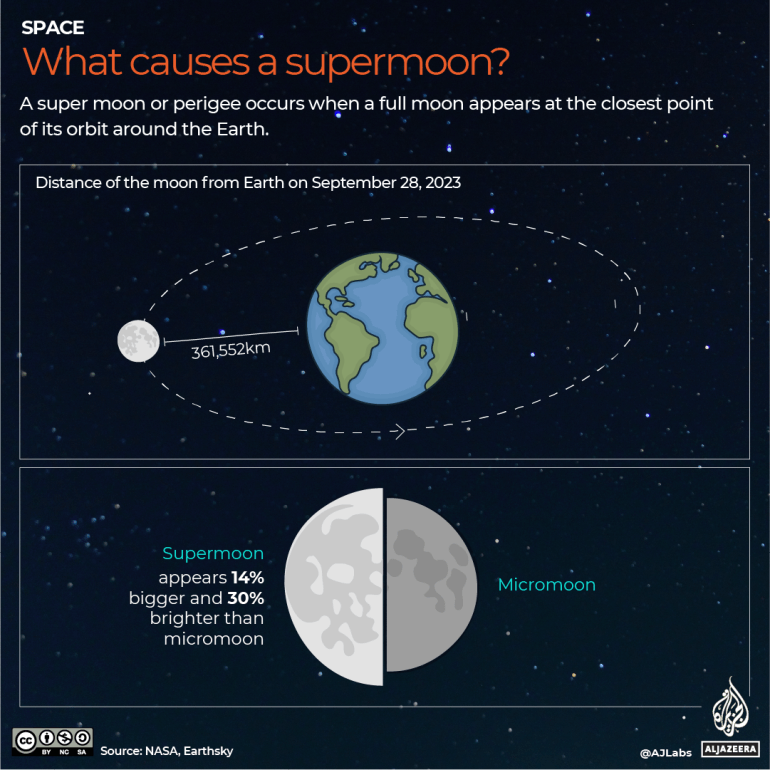On the night of September 17, the Earth, Sun and Moon will align to create three celestial events.
In many places, depending on time zones, people will be able to see the Harvest Moon, Super Moon, and Lunar Eclipse with the Full Moonrise.
Here’s what you need to know about these events:
First of all: What is a full moon?
According to NASA, a full moon is defined as the moment when the moon is completely upright. 180 degrees On the opposite side of the Sun, during this time the Sun illuminates the Earth’s Moon almost completely.
NASA says this month’s full moon will peak on Tuesday, September 17 at 10:35 p.m. EST (or 02:35 GMT on Wednesday, September 18).
Full moons typically rise at sunset and set at sunrise. The moon cycle consists of eight phases that repeat every 29.5 days.
What is a partial lunar eclipse?
A partial lunar eclipse is when the Earth’s shadow covers part of the full Moon.
The shadow expands and then recedes, but never reaches totality. In contrast, during a total lunar eclipse, the Earth’s full shadow covers the entire Moon.
The Moon will begin moving into Earth’s partial shadow at 8:41 p.m. EST. Tuesday (00:41 GMT Wednesday). The initial dimming may be slight until the upper edge of the moon begins to enter full shadow at 10:13 p.m. EST Tuesday (02:13 GMT Wednesday).
The eclipse will peak at 10:44 p.m. ET on Tuesday (02:44 GMT on Wednesday), when only the top eight percent of the moon will be in full shadow.
The moon will emerge from full shadow by 11:16 p.m. EST (03:16 GMT) and will complete its exit from partial shadow by 12:47 a.m. EST, or 04:47 GMT, on Wednesday morning.

What is a supermoon?
This moon will also be a supermoon.
A supermoon is an astronomical phenomenon in which the moon appears larger and brighter than usual. This happens when a full moon occurs at the same time as its orbit is closest to Earth.
According to NASA, the term “supermoon” was coined by astronomer Richard Nolley in 1979 to describe a full moon that occurs when the moon is “90 percent of its closest approach to Earth.”
Essentially, the Earth, Moon, and Sun are in a straight line at this point. At the opposite end of the Moon’s visibility spectrum is the micromoon – when a full Moon appears especially small and faint because it coincides with the point in the Moon’s orbit when it is farthest from Earth.

Is this also the harvest moon?
The Harvest Moon is the closest full moon to the autumnal equinox in the Northern Hemisphere, which will occur this year on September 22 at 12:43 GMT.
So yes, this is also a harvest moon.
According to the Farmer’s Almanac, “This full moon rises at about the same time time – At sunset – for several evenings in a row. “This results in an abundance of bright moonlight early in the evening.

This phenomenon has traditionally helped farmers harvest their summer crops by giving them several extra evenings of moonlight. Hence the name Harvest Moon.
The Harvest Moon appears orange and red, and appears larger and brighter than other full moons because of an optical illusion that occurs as the Moon approaches the horizon.
It gets its color because the moon’s light is filtered through more molecules in Earth’s atmosphere than it is higher up.

So, how will Tuesday’s events go in general?
- The Moon will reach its peak on Tuesday at 10:35 p.m. EST (Wednesday at 02:35 GMT). At this time, it will also reach its peak illumination.
- The eclipse will peak at 10:44 p.m. ET (02:44 p.m. GMT).
The total duration of the partial lunar eclipse is four hours and six minutes.
For observers in the U.S. Eastern Time Zone, the eclipse will reach its darkest point around 10:44 p.m. EST on September 17.
In Europe and Africa, the eclipse will be visible during the early morning hours of September 18. In the UK, the eclipse will be most visible around 3:44 a.m. GMT on September 18.
Gulf residents will not be able to see the peak of the eclipse, but they will be able to see the moment the partial eclipse begins at 05:15 a.m. local time on Wednesday.
In the map below, you can see which countries will be able to see the peak of the eclipse on Tuesday.

How to watch the lunar eclipse and harvest moon?
If you are in the right time zone, the average stargazer can see the lunar eclipse, although it is best to be in darker locations.
NASA It is also recommended Using a pair of binoculars “at least 7 magnification,” noting that “10 or 15 magnification will provide more detail; you may need a tripod to steady them.”

“Devoted student. Bacon advocate. Beer scholar. Troublemaker. Falls down a lot. Typical coffee enthusiast.”

